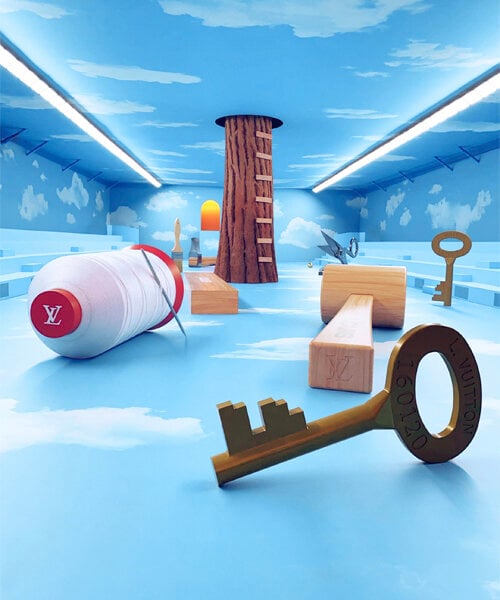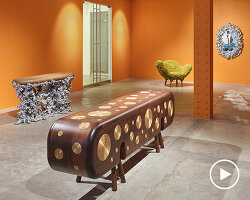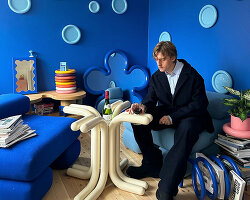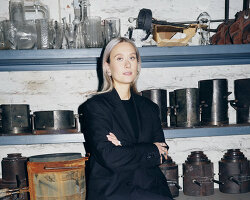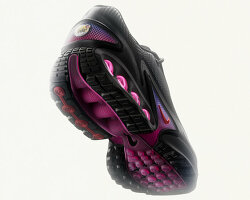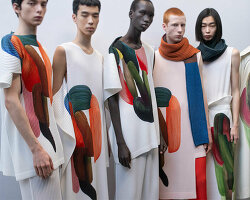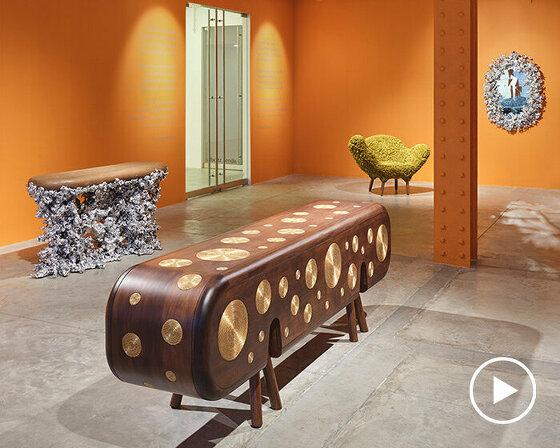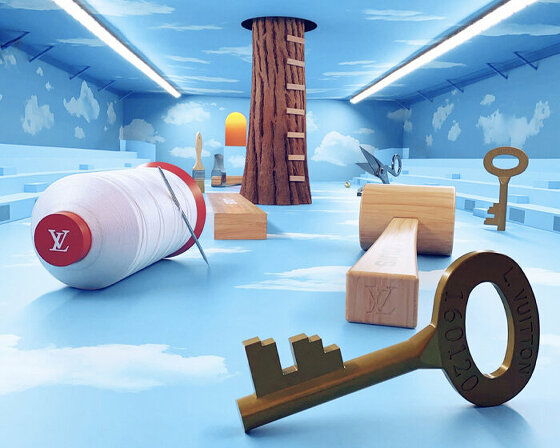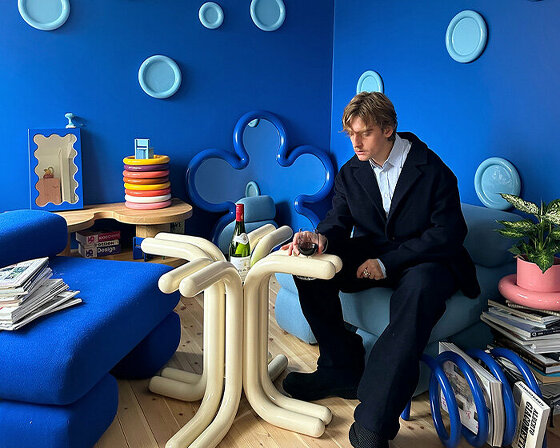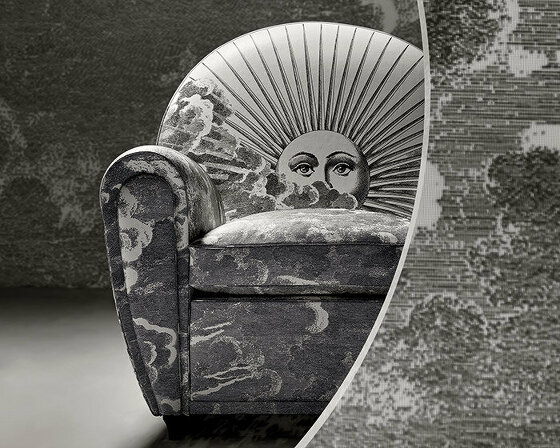PLAYLAB, INC. on celebrating 20 years of creative boom
From fashion shows to films, music videos, artworks, and retail, PLAYLAB, INC. knows no creative bounds. Founded in 2009 by Archie Lee Coates IV and Jeff Franklin, the LA-based studio is driven by ‘an extremely multidisciplinary’ vision and hunger for experimentation, collaborating with the likes of Bottega Veneta, Louis Vuitton, Post Malone, Nike, and many more. This years marks PLAYLAB’s 20th anniversary, two decades of incredible growth which Archie shares at length with designboom. ‘The vision and the intention for the studio has never changed. We wanted a freeing place for ourselves, and eventually others,’ he says.
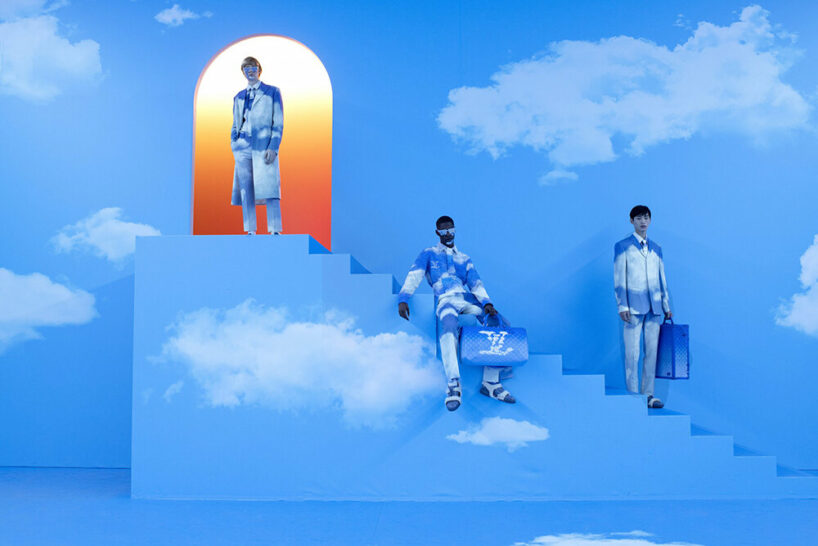
Louis Vuitton FW20, Paris | all images courtesy PLAYLAB, INC.
A team of twelve creatives, PLAYLAB, INC. has concocted over the years an eclectic portfolio that bursts with colors, energy, childlike whimsy, and soul. Some of its most iconic works include a series of immersive set designs for Louis Vuitton in the care of Virgil Abloh, each one more show-stopping than the next; a giant installation for Marc Jacob‘s iconic ‘The Tote Bag’, squeezed into an NYC alley; a pop-colored retail interior for Madhappy‘s West Hollywood store; a dreamy creative direction for Rimowa‘s SEIT 1898 exhibition and, more recently, a trippy collaboration for Justin Timberlake‘s 6th studio album ‘Everything I thought It Was’. Read on as co-founder Archie shares his honest and heartfelt story of building PLAYLAB’s twenty-year legacy in an exclusive designboom interview.
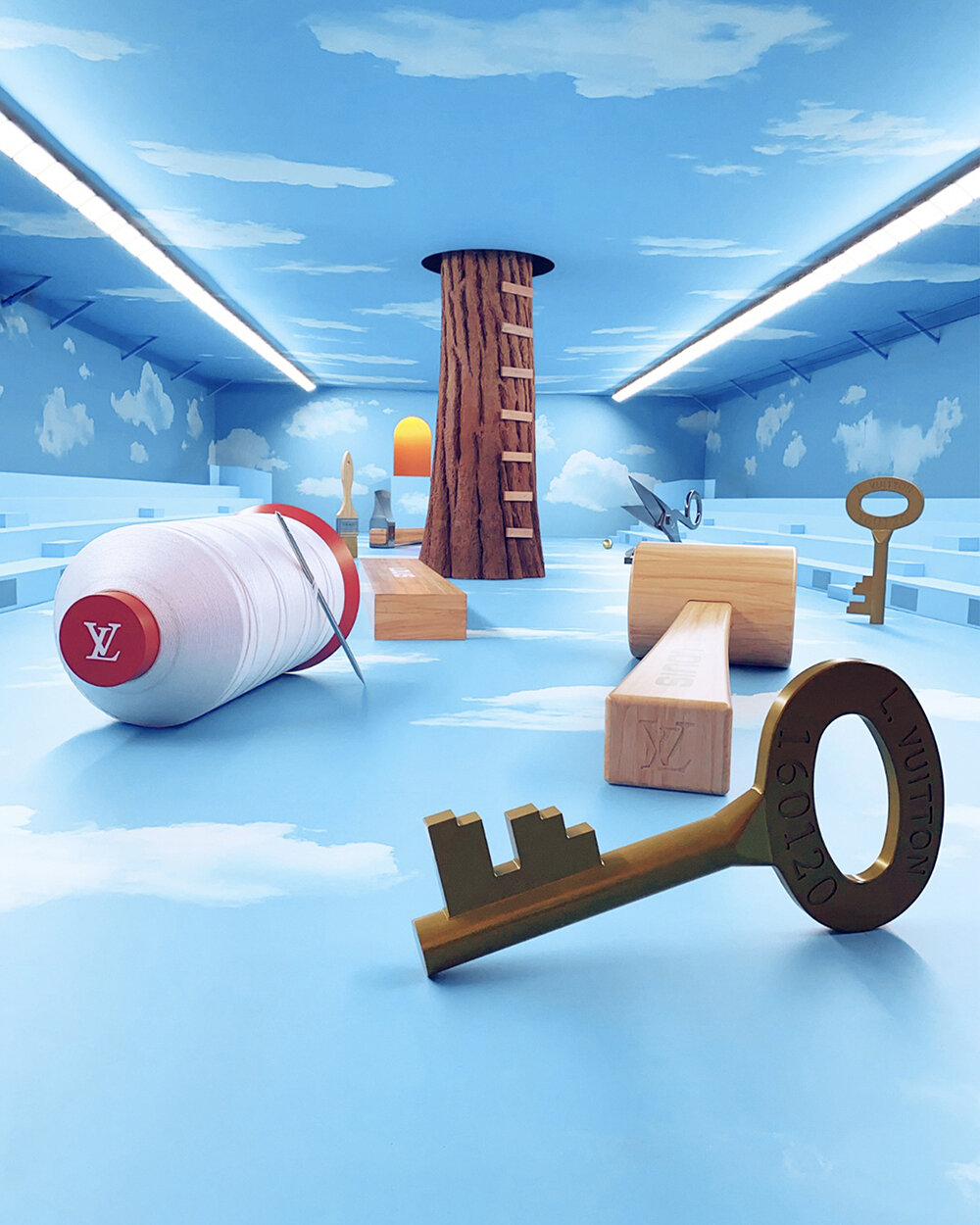
Louis Vuitton FW20, Paris
interview with co-founder archie lee coates iv
designboom (DB): Walk us through how PLAYLAB was founded and what drives your vision as a team.
Archie Lee Coates IV (ALC): In a studio at Virginia Tech Architecture School, I met my partner and best friend, Jeff Franklin. You know how architecture schools can be a really rigorous environment — and as a young kid, at 18, your brain is sort of exploding with possibilities. You’re getting all this new intake of information, you’re learning all these new references. Jeff and I had struck up this friendship in our second year design studio, and we were there all the time. We only left for other classes, and pretty much slept at the studio half the time. You’re just living this very dedicated life to design, and we kind of realized how intense it was. So we would leave the campus, and we would go downtown to this coffee shop. We would draw on napkins, and we would get ideas out very quickly, because we were taught to iterate very quickly. And so it was at 19 years old, exactly 20 years ago, this year, that we came up with PLAYLAB; I learned HTML and built playlab.org. We made it look like a really professional design studio and started taking on projects in college. I then moved to New York, right after Jeff graduated college, and got a tiny studio, and just kept building; it was sort of off to the races from there.
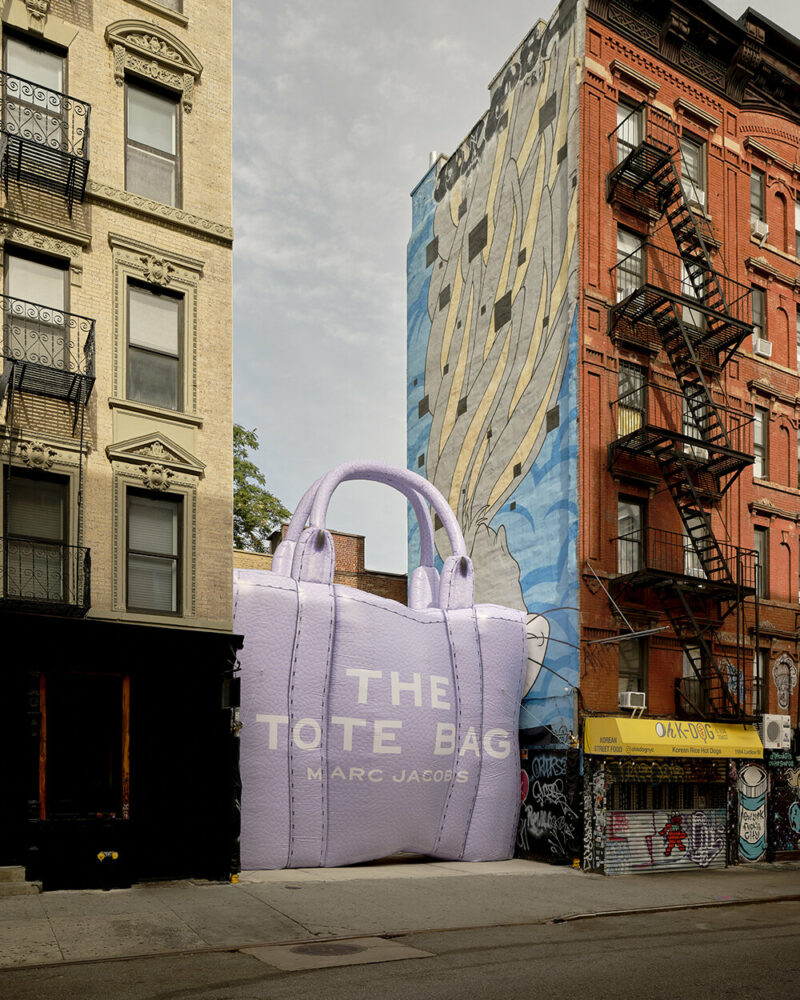
The Tote Bag NYC Installation
The vision and the intention for the studio has never changed. We wanted a freeing place for ourselves, and eventually others. Now we’re twelve people and growing quite fast. But for a long time, it was just Jeff and I. We wanted to frame a place for us to try anything that we wanted to, within art and design; to not necessarily be boxed in by a category or discipline or a skillset or a tool or anything like that, which means that all of the work has to be centered around an idea or concepts — and we have to be extremely interested in it. And we have to have healthy relationships with the people that we’re working with, whether they’re clients or collaborators, or partners, or all. So that’s why we call it PLAYLAB, almost very naively.
I remember in 2010, we didn’t want to name it PLAYLAB anymore. You know, it just feels so corny. But a close friend of ours had told us that the name has a meaning and significance; you have to keep its naivety alive with it. And so Jeff and I have worked very hard to build and protect the idea of the studio and the team that sits inside of it. It’s just extremely important to us. And the way we run the studio is quite unique, which maybe is clear from the output. But really, the beauty of the studio is what is inside and these incredible people that we have here. It’s to learn and to listen to them, and to try new things and see what they want to make.
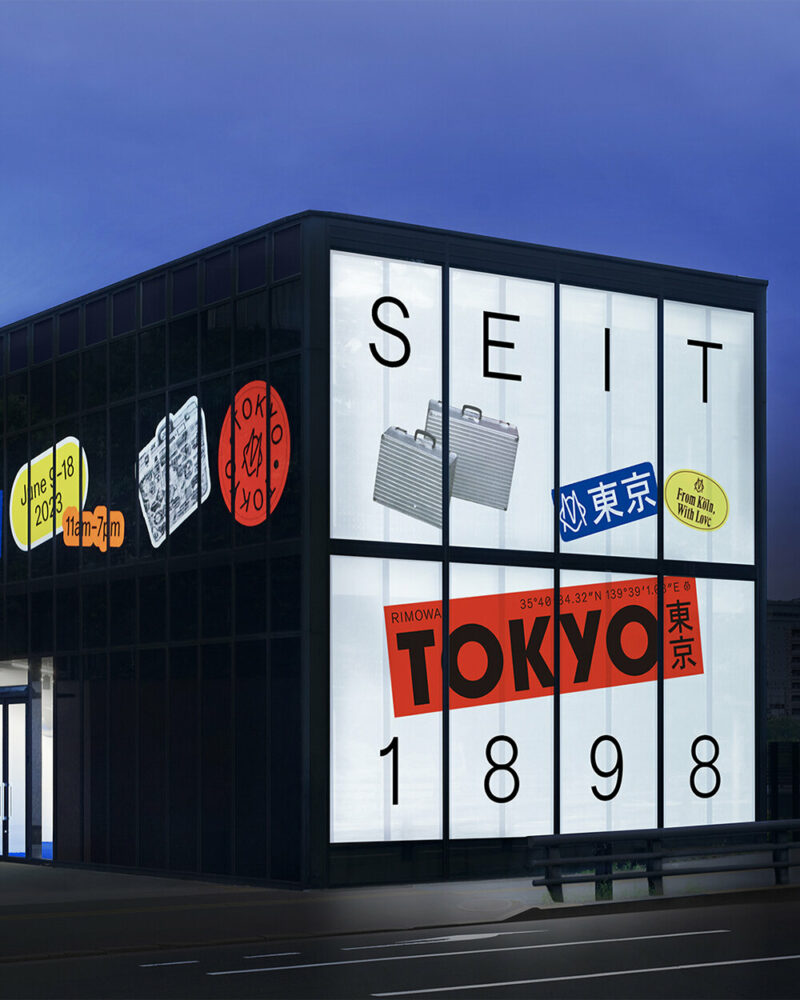
Rimowa SEIT 1898 exhibition
It’s a safe place to fail. We do fail and make mistakes. And we’re trying to get better at that all the time. I wake up every day, Jeff wakes up every day, and we’re excited to come into this place. It means everything to me that I’m afforded the opportunity to have this studio and be with these people and go into the unknown — not knowing what we’re going to make or achieve or see. Jeff and I had this analogy in the early days of PLAYLAB. In 2007, we got our first studio in Brooklyn, New York; it was a closet-sized space that had no heat. Jeff said: ‘The whole goal is just to climb the mountain. So that when we get to the top of one mountain, we can see the top of the next and then go back down and then back up‘.
We were reflecting with a new client the other day. He’s a very spiritual guy, and he asked: ‘Hey, Jeff, when did you see the moment that Archie grew professionally for the first time?’ Jeff had all these moments. And I had all these moments for him. I’m just very thankful for the health of the relationship and the dedication that he’s had, and hopefully I’ve had, to try to see this through to the end. And we don’t know what it’s going to look like, I don’t know how big it’s going to be. I don’t know what we’re going to make. But that’s the point. I just want it to be a good and an educational time for the people that are here, when they’re under our roof.
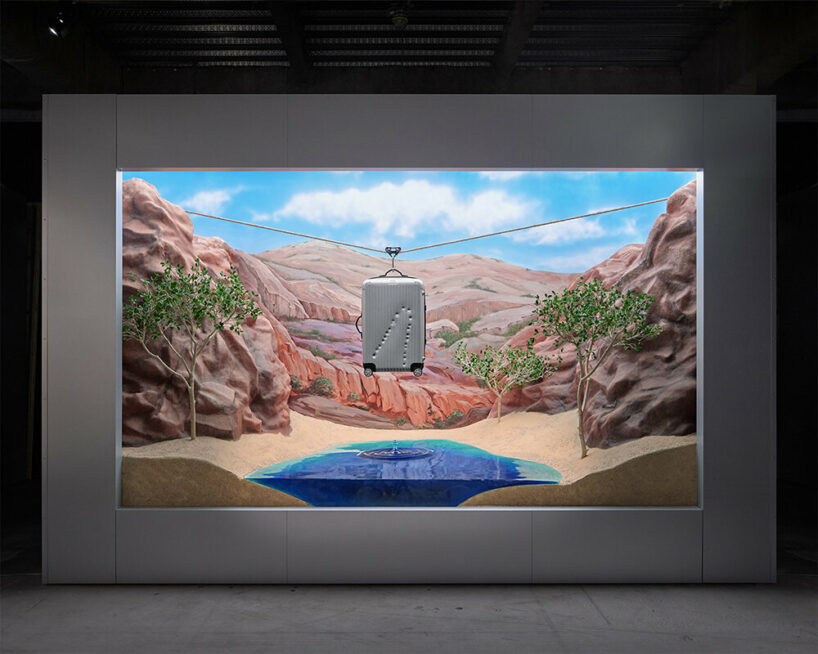
Rimowa SEIT 1898 exhibition
DB: Your body of work is incredibly versatile — ranging from scenographies to music videos and retail interiors.
Can you give us a more detailed overview of your portfolio, and how it evolved over time?
ALC: From day one, we haven’t changed the description of PLAYLAB. We’ve always called it an extremely multidisciplinary, creative studio with no particular focus. That’s the tagline. We’re trying to make that continually true and more expansive. That was the vision initially, but we had not yet done any work. Like many people, we were inspired by the offices of Charles and Ray Eames, where they were working on animations, architecture, sculpture, film, and furniture. There was an explosiveness of creativity that felt freeing. So we wanted that, and we have that now.
But if you ask Jeff and I, any day of the week, we think that we’re starting today. It may look diverse from the outside in terms of project categories, but to us, it seems like we’re just scratching the surface of what’s possible here. And, in the beginning, we didn’t have budgets or clients. There was no Instagram: we had no reach, and we had no ‘sphere of influence.’ We had nobody that believed in us or trusted us. In fact, there was a lot of laughter for most of our first several years in New York as a company. You had other friends starting design studios, and PLAYLAB was this sort of strange, cute, and special project. We still get that, but that’s all we got then.
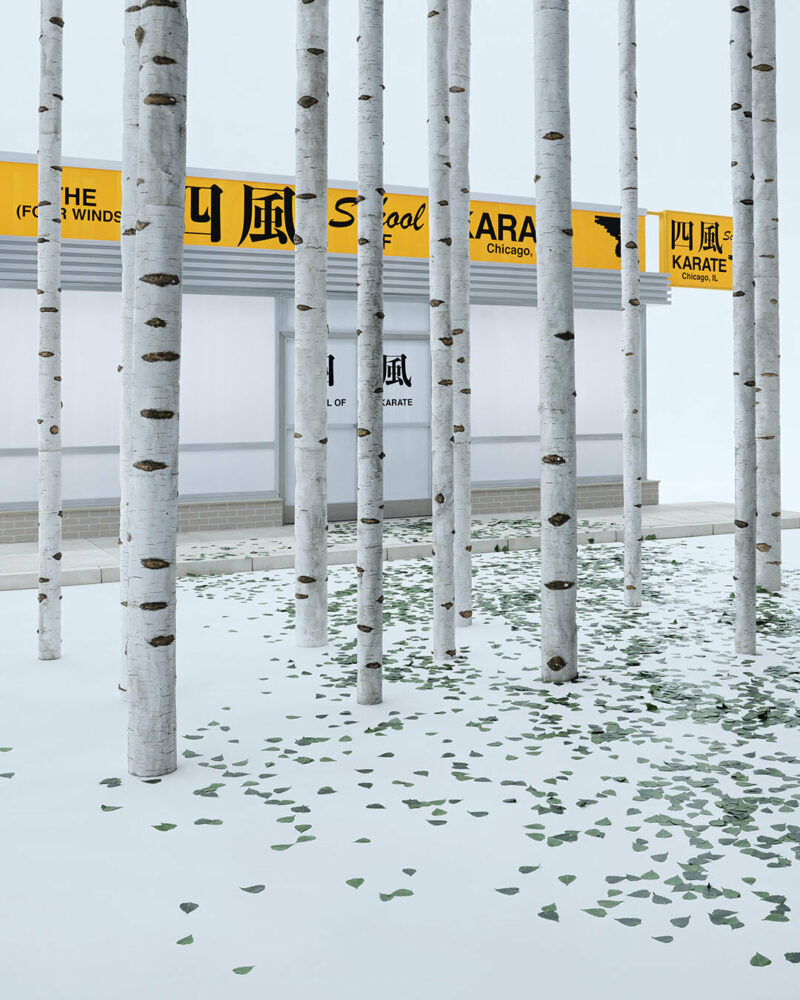
Louis Vuitton SS22, Paris
Tibor Kalman has this monograph on his life called ‘Tibor’, and in the beginning, there are all these sorts of aspirational truths about practice that we hold very dear. One of them read to the effect of: You want to find the crack in the pavement, the creative lunatic, the one that sees the world the way you do, and has the money to do it. And your goal is to work with them, use that money to change the world, and hold on to them for dear life. And so we look for those people every day! And PLAYLAB has grown, thankfully, and we’re very privileged, humbled, and honored as a result. But it’s grown and changed because of the individuals who believed we could do something. It’s never about what we’ve done.
Let’s take Madhappy’s West Hollywood store as an example; before that, we had not done permanent retail. We had done some retail and some architecture, but we had never done permanent retail at that scale, with that budget, and neither had the clients. We just wanted to go on a journey. To us, that project symbolizes the relationship to these incredible people who work at Madhappy and who trusted us on this very long journey to create something beautiful that would stand the test of time. And now we’re launching other collaborations with them!
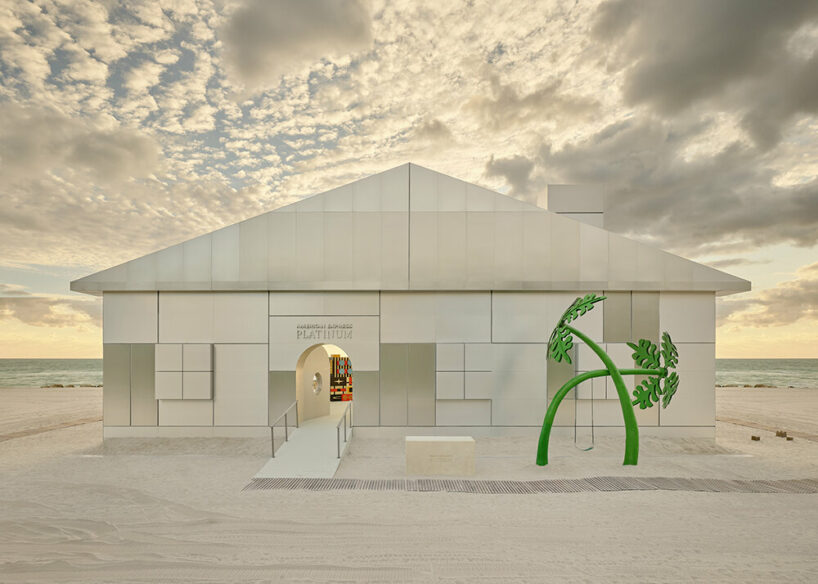
American Express installation Art Basel Miami 2023 | image © Sean Davidson
We do do retail, we do do stage design, we do runway shows, we make music videos, we’re writing films, right now, we’re writing theater plays, we’re designing graphics and identities and packaging and books, and we have a lot of furniture we’re designing this year. We’re working on a shoe- we’ve worked on shoes for a very long time- and we are finally making one with a brand. We’re a partner in a fashion company. We also just shot three campaigns in the past couple of weeks. There’s so much that’s happening here, and it’s everything that we kind of wanted in the beginning. It’s extremely difficult to do, and we’re trying to figure out the constant balance to make it explosively enjoyable all the time. The variables are always people, time, and money, and all these things. It’s about just getting better and more equipped throughout that process.
There’s an easy way to think about it for us: we’re working in a privileged space of art, culture, music, and fashion design. That may evolve, but really, that’s where we’re at. We can kind of ebb and flow and move into all these different areas and categories based on interests. We’re currently working with an artist in Nashville to design a cover for their album. I’ll also be heading to London for another musician, putting on a concert and doing a late-night performance where we’ve designed a set. These are just the things we’re actively working on, not the things we will be working on in a couple of weeks or months.
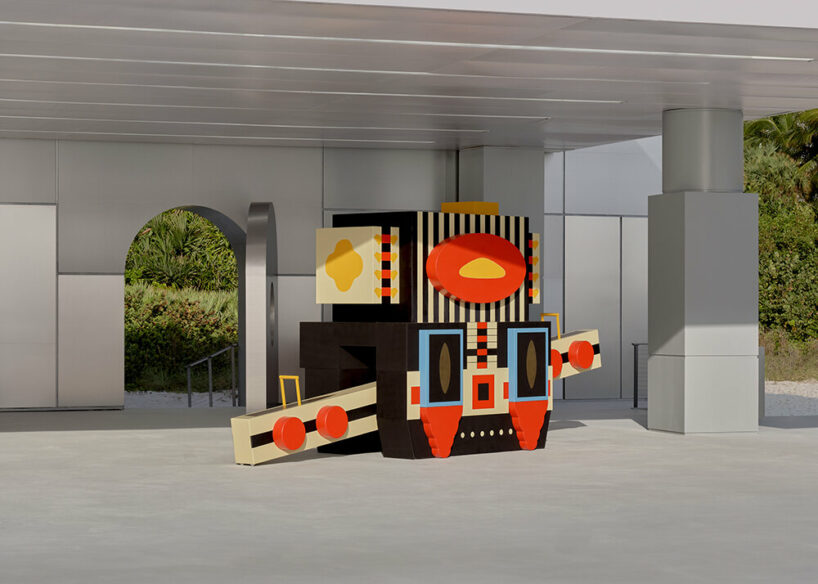
American Express installation Art Basel Miami 2023 | image © Sean Davidson
DB: You mentioned the Madhappy West Hollywood store. How did this memorable collaboration come about, and what inspired the design, colors, and material selection?
ALC: Madhappy is a clothing brand concocted by these three incredible guys. There’s a component to the business that is about optimism and happiness, specifically about mental health and finding or building resources for mental health. This should be important and meaningful to everybody, but it is extremely important to Jeff and me; it’s something we battled, just like anybody else. We spent a lot of time having conversations with the founders about it — about what their mission was, about what their purpose was, and the difference of retail and mental health. Through several talks, you learn very quickly that they’re really committed to conversation. Although they’re not mental health experts, they do work with them.
When we do anything at PLAYLAB, we try to get to the core of what the soul of the thing is, build a world around that, and find the truth. Jeff calls it ‘finding the diamond’ — finding the thing that maybe other people don’t see clearly and building inroads to guide them through that diamond in a much more beautiful and celebrated way. Everybody needs that. For Madhappy’s founders, we realized that their soul is all about conversation and community, and they do a really good job at it. They really see, hear, and listen to people and build a platform for a diverse group of collaborators; it’s very rare that we’ve seen it like that.
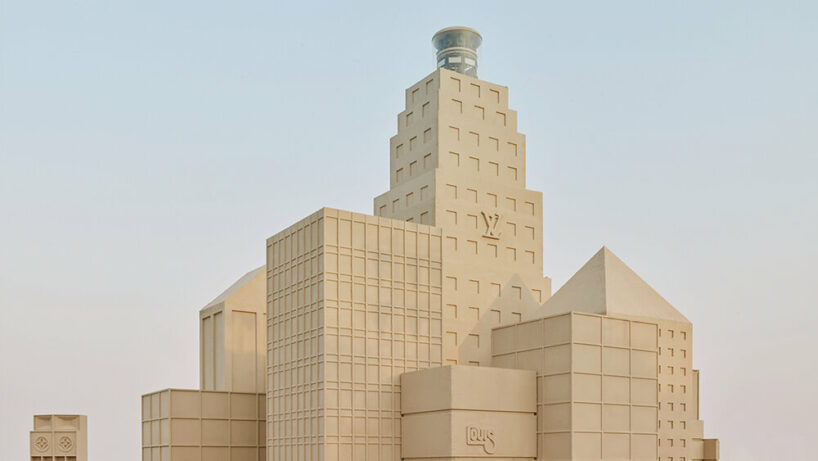
Louis Vuitton SS23, China
We symbolize that in very simple ways — starting with an F&B program, which is not new; people do this in retail. But let’s have one, and let’s use that to be a platform. We involved all of their friends who have companies throughout LA to have a home, a tiny home. We then created a meeting space that allows people to come in and talk together in a circle/oval. The retail part is really just on one wall; it’s a long linear bar that stretches programmatically through the space. And then there are a couple of other merchandising moments and racks. We spent a lot of time going to various buildings and retail environments to get up close and personal with materiality and understand what’s possible within budgets and how material speaks to that specific concept. Madhappy has a quality or a design level that I think could be overlooked because it’s such a happy and collaborative brand.
We wanted to make sure that when people walked in the space they could see very clearly that every element was chosen based on a careful decision. Even if it’s a white wall, it’s how it was speckled and applied. Every rack is custom, every table is custom, and the concrete of the floor is custom. I think intentionality goes a long way, even if it’s subconscious for the people walking into that space. Now, as Madhappy grows and expands and has more footprints across more countries and cities, the question becomes: How do you continue to grow and expand that ‘soul’ and make it more available to more people, and become more and more authentic all the time.
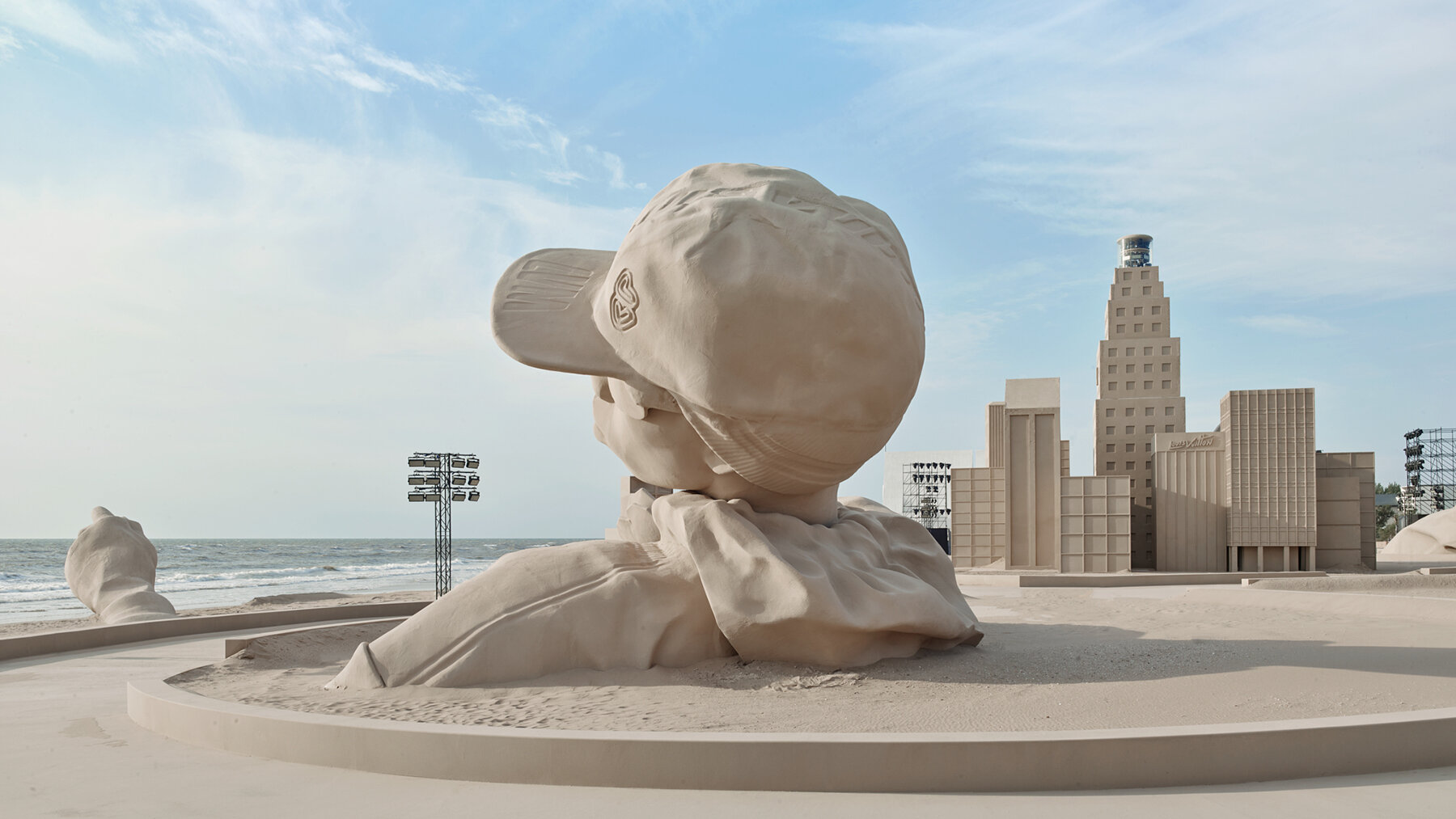
Louis Vuitton SS23, China
DB: Moving on to your scenographies, you’ve completed quite an impressive series of set designs, namely for Louis Vuitton, with Virgil Abloh. Any particularly memorable ones, or one, in mind?
ALC: Back to the people who believed in us or gave us an opportunity — the greatest on that list is Virgil Abloh. He was potentially the greatest person we’ve ever met in our lives. He was an absolute genius, an absolute friend, and an absolute, empathetic, talented human being. When he asked us to do our first show with him, with Louis Vuitton, that felt like a movie; Why us? Why would you trust us to do that? And we worked really hard on that first show, thinking that it would be the last time we got to do anything like that, let alone for Virgil Abloh. And we kept working with him until he unfortunately passed in 2021. Every set design we collaborated on with him will be the greatest work for us. We think a lot about if he were still here and how we continue to make him proud, knowing that that’s an impossible task. We really enjoyed the friendship and the collaboration; the choreography, the music, how everything came together and created this feeling or emotion that you can’t describe. Those sets were just magical. I don’t even want to single one out. They were all very special.
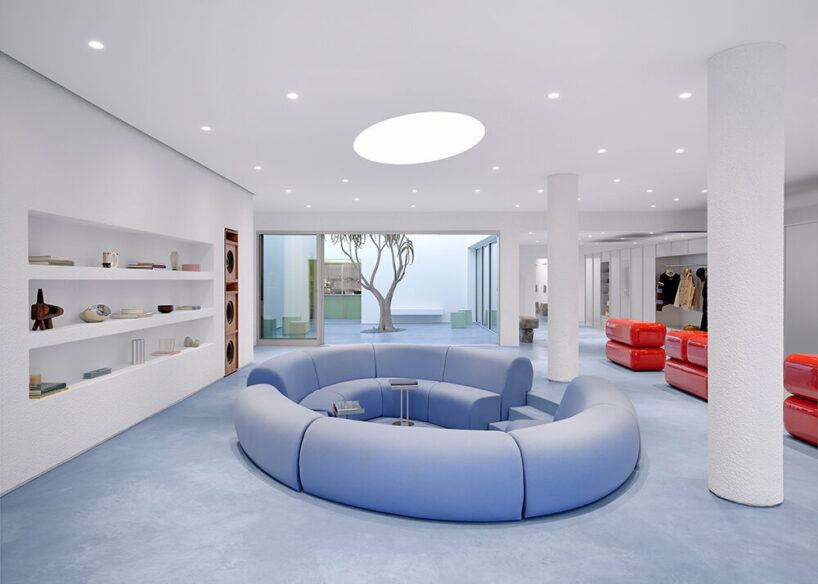
Madhappy West Hollywood store | image © Sean Davidson
DB: Your works also feature inflatable and bubbly designs that emulate a sort of childlike wonder and play. Talk to us about this aesthetic.
ALC: Building on the naivety of PLAYLAB — I remember it was 2014 or so and Jeff said: ‘Man, I would love to do an inflatable!’ Our inflatables are definitely inspired by the Macy’s Day Parade. I remember this woman approached us and said she’s got this commission to give to an artist to propose public work, a temporary public work in midtown Manhattan on the Avenue of the Americas. We thought, wow, this could be the opportunity because there wasn’t a massive budget, so we contacted an inflatable company in Ohio to enquire, and they gave us the price, which really fit the budget. With inflatables, you can achieve scale relatively quickly and cost-effectively, so we did this work called Grown Up Flowers and kept it going for a bit.
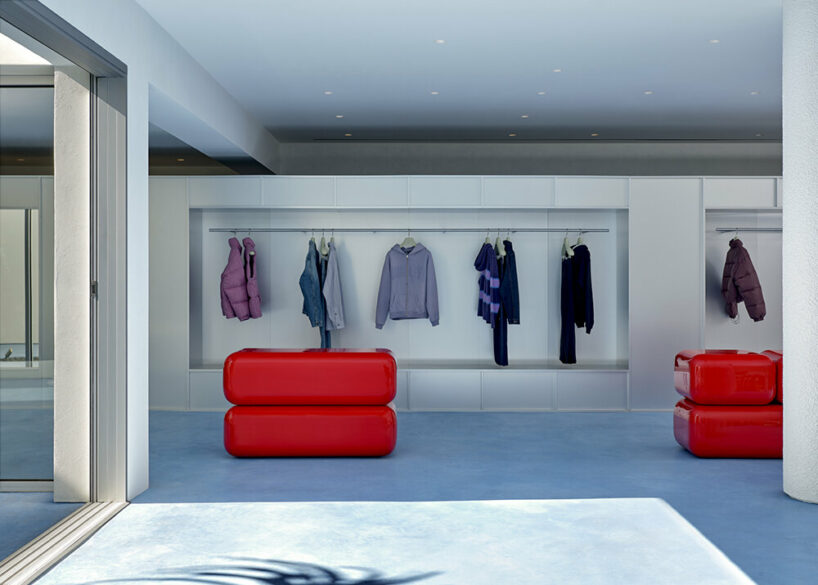
Madhappy West Hollywood Store | image © Sean Davidson
Then Virgil saw the installation and said: ‘That’s the language of kids!’ At that time, he was exploring, through Louis Vuitton, the journey of boyhood and becoming a ‘man’ and what that means and how people see it. Based on his vision, we designed 50 bounce castle versions, and one was made for the show. We started getting publicity for it, and people started coming to us, but we had to say no to many of them because we didn’t want to be known as the inflatable people (laughs). After a while, it’s just not fun; it’s about when it makes sense. With Marc Jacobs, it made absolute sense, and there’s an intention now for the Macy’s Day Parade.
As I mentioned, we’re celebrating our 20th this year and building a new playlab.org. Ana and Dillon, senior design directors of PLAYLAB, who have been with us for five and six years, respectively, were not too sure about us needing a website because Instagram was doing all of the heavy lifting to show our projects. That was a great point, so why not dedicate the website to things we want to make, not things we have already made? Internally, we’re just calling them proposals and one of those proposals is doing an inflatable for Macy’s — that’s the pinnacle, and then maybe we can put that category to bed for a second.
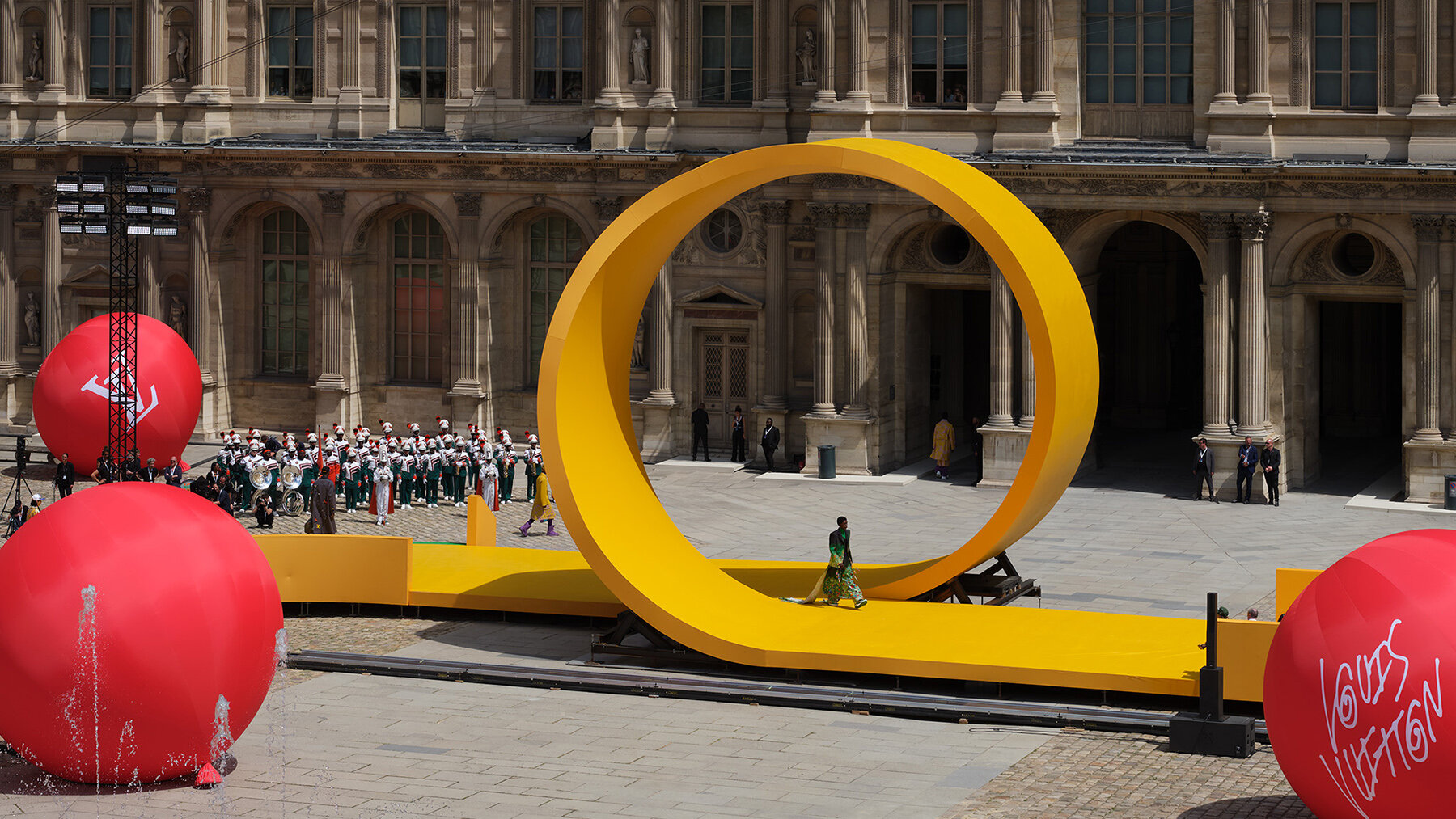
Louis Vuitton SS23, Paris
DB: And what other proposals or dream projects do you have in mind?
ALC: Personally, Disney would be amazing! But everyone has different dreams here. Ana, for example, really wants to work with Stevie Nicks and Fleetwood Mac. We talked about it and thought about proposing a substantial documentary on Stevie Nicks. That’s pretty much how things come to be at PLAYLAB! If the people we’re working with are great, the ideas are good, and we have a good team, then we move forward. We’ve also always dreamed about outer space, like rocket companies; we’ve dreamed about animations, working with specific directors on film, having our own late night TV show.
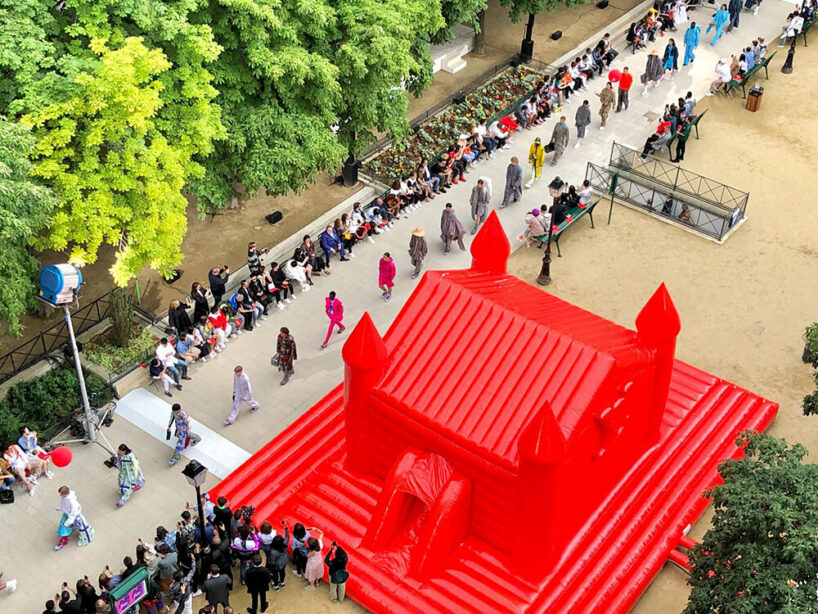
Louis Vuitton SS20, Paris
Speaking of directing, when Post Malone came to us, we knew that he made cool music, but we were so surprised by how awesome of a person he is: brilliant, talented, kind, loving, empathetic, and communicative. I like the surprises, the unexpected things. I didn’t think we’d work with Post Malone; he wasn’t on the list. So I’ve kind of learned to not have a list! I’d like to make a piece of electronic music equipment with Teenage Engineering; I think that would be really fun. Even though that’s highly specific, I guarantee that if our team had to work on that, they’d be excited. Right now, we’re working with Alessi in Milan; that was a dream! I’ve been collecting Alessi, as did Jeff and his dad, a collector of antiques. It’s a very spiritual and meaningful thing for us all to work with them in any capacity. We also get to work with our friends from Studio Temp, this graphic design office we met through Virgil. To sum it up, this process feels really good, and we’re always asking ourselves: Cool, what’s next?
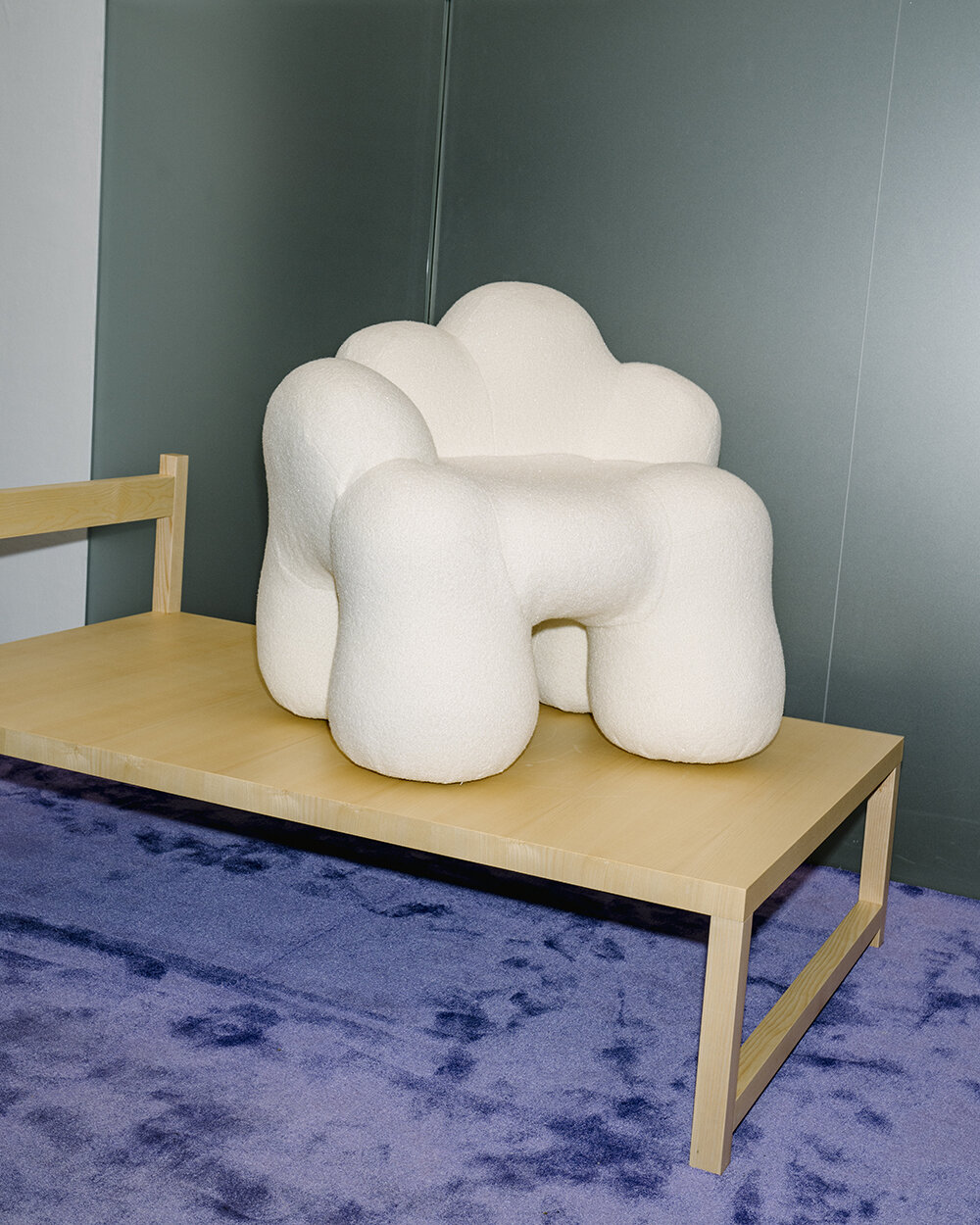
StockX and Daniel Arsham – Art in Residence | work © Eny Lee Parker
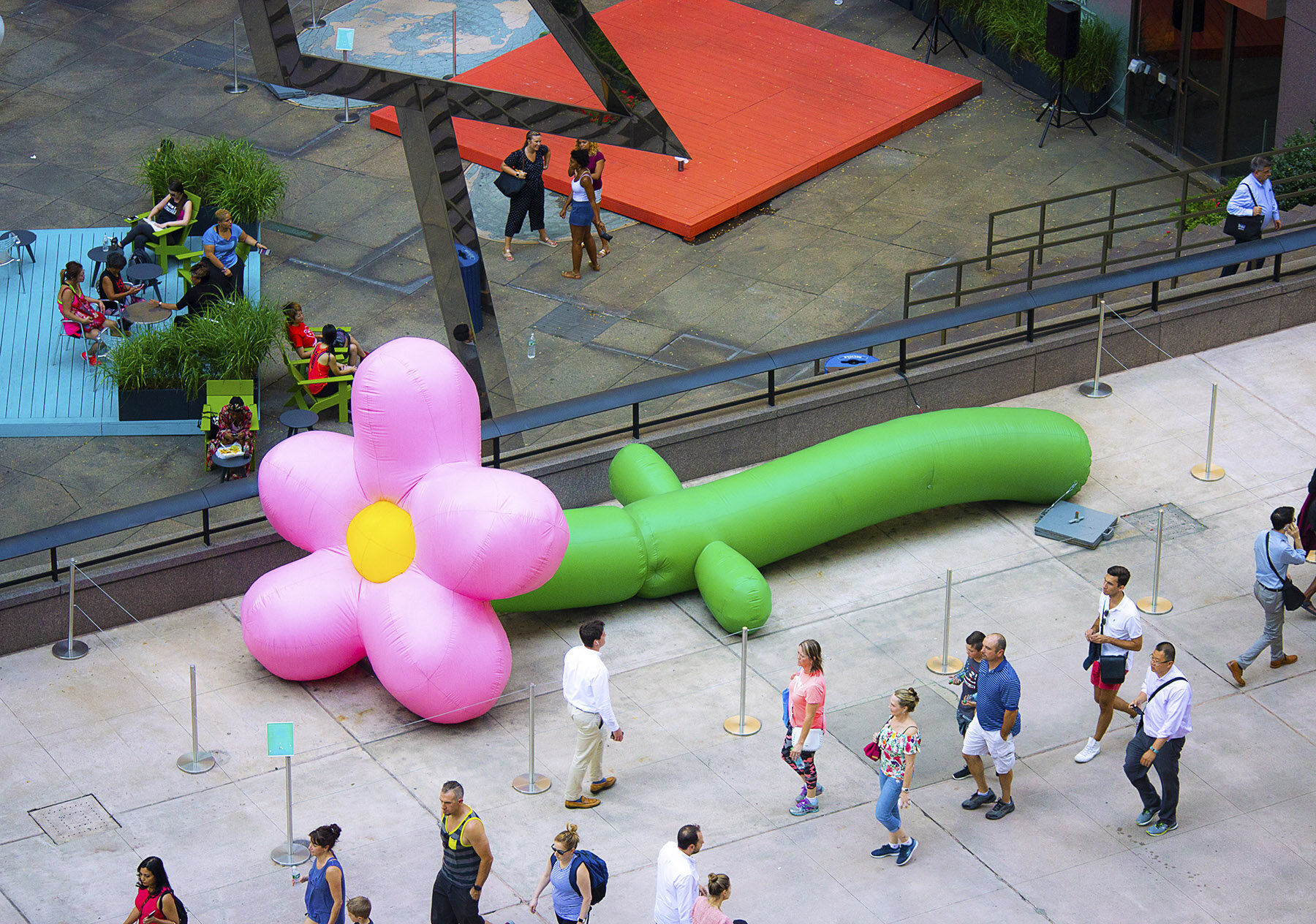
Grown Up Flowers ‘Rose’ in Manhattan
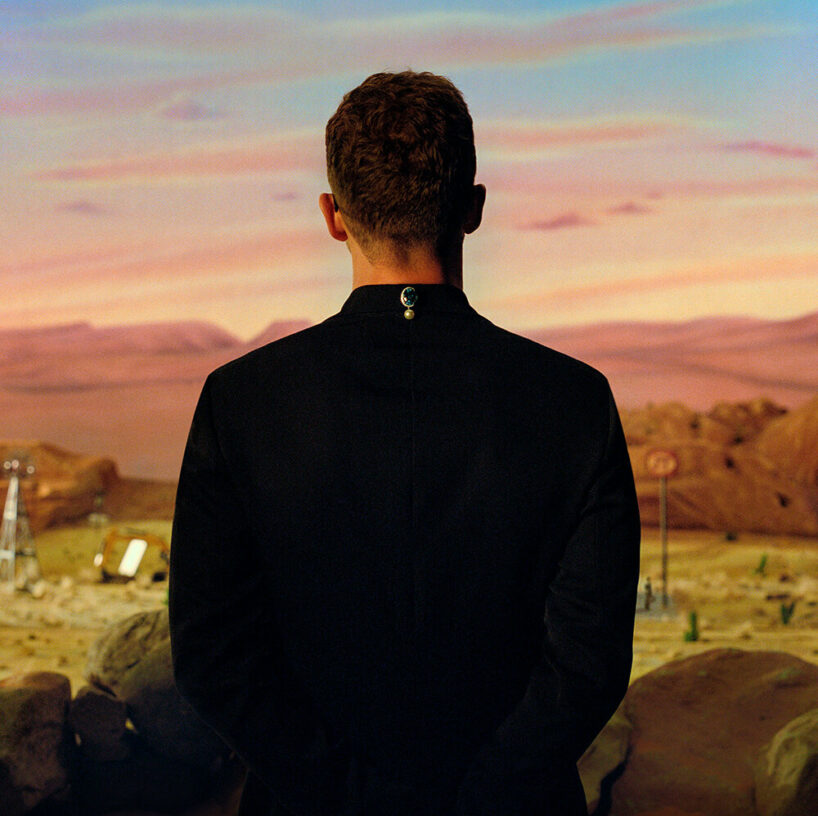
Justin Timberlake’s 6th studio album cover
Justin Timberlake – ‘Selfish’ music video
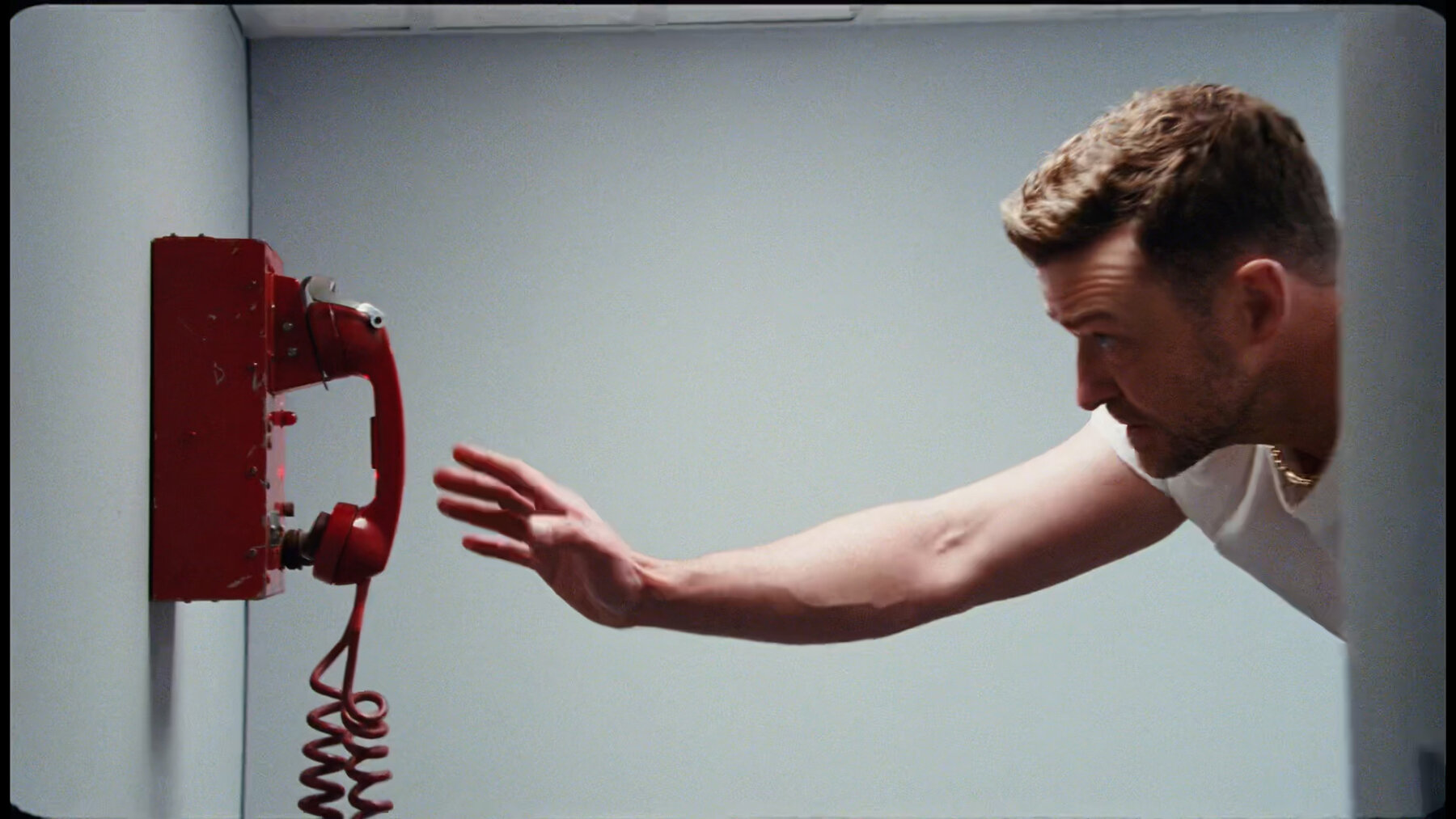
Justin Timberlake’s 6th studio album trailer
project info:
design studio: PLAYLAB, INC. (here) | @playlabinc
interviewee: Archie Lee Coates IV | @ottomilo
DESIGN INTERVIEWS (40)
PRODUCT LIBRARY
a diverse digital database that acts as a valuable guide in gaining insight and information about a product directly from the manufacturer, and serves as a rich reference point in developing a project or scheme.
